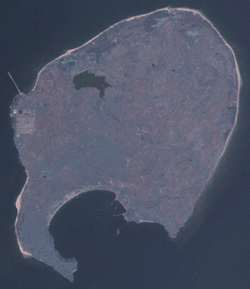Weizhou Island
 |
|
| Geography | |
|---|---|
| Area | 24.74 km2 (9.55 sq mi) |
| Length | 6.5 km (4.04 mi) |
| Width | 6 km (3.7 mi) |
| Coastline | 15.6 km (9.69 mi) |
| Administration | |
|
China
|
|
| Province | Guangxi |
| City | Beihai |
Weizhou Island (simplified Chinese: 涠洲岛; traditional Chinese: 潿洲島; pinyin: Wéizhōu Dǎo) is a Chinese island in the Gulf of Tonkin. The largest island of Guangxi province, Weizhou is west of Leizhou Peninsula, south of Beihai, and east of Vietnam. Administratively, it is part of Weizhou Town, Haicheng District of Beihai City.
Its north-south length is 6.5 kilometres (4.0 miles), east-west 6 kilometres (3.7 miles). The coast is 15.6 kilometres (9.7 miles), with 6 to 10 kilometres (3.7 to 6.2 miles) of sandy beach. Weizhou rises in the south, where Nanwan Port (南灣港; pinyin: nánwān gǎng) is located. Calm and shallow waters around the island support varieties of marine life including megafaunas occasionally appear such as whale sharks and bryde's whales.
From 1869 to 1879, the French built a Gothic-style 15 metre Catholic church in Shengtang Village (盛塘村; pinyin: shèngtáng cūn), Weizhou. Weizhou Chengzai Church (城仔教堂) was built in 1880, also by French Catholics.
Weizhou Dao is China's youngest volcanic island. Its origin is probably from a mantle plume that rose 50–32 million years ago, as a result from the collision of the Indian and Eurasian plate. When the plume reached the asthenosphere, it helped to create the South China Sea by the plume's lateral flow. An evidence that the plume still exists is that a lot of basalt has since the Pliocene erupted in the South China Sea and its adjacent areas, for example the Yandunling 烟墩岭) and Yantouling (烟头岭) volcanoes, Leiqiong (雷琼) volcano group, Weizhou Dao and Xieyang Dao.
...
Wikipedia
